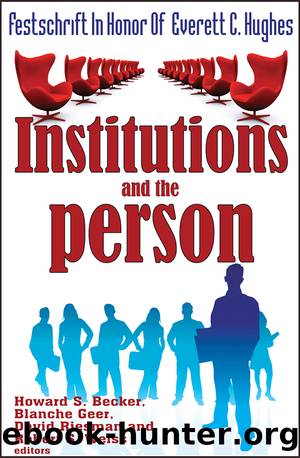Institutions and the Person by unknow

Author:unknow
Language: eng
Format: epub
Tags: Social Science, Sociology, General
ISBN: 9781351512251
Google: BR4uDwAAQBAJ
Barnesnoble:
Publisher: Routledge
Published: 2009-10-15T00:00:00+00:00
Some Ambivalences in Academic Innovation
Each of our three educational institutions sought to provide an educational service not previously available, either to a particular constituency or perhaps to any consistency. Parsons College was in this respect the least ambitious. Its original aim was to enter the market for students looking for a second chance at a private college B.A. which would be legitimate but not unduly taxing. It had the further aim of showing that neither college faculties nor outside philanthropy needed to subsidize students, but that places could in effect be auctioned off and colleges run at a profit. It was especially this latter aim that the re-founding president preached up and down the land. But like so many evangelical Americans, the president got religion even while disavowing any but profit-making motives. Not only did he proudly bring several high-priced professors, whose courses would presumably not be subject to cost-benefit analysis, but he started to give scholarships, both to worthy bright students and to worthy poor (often Negro) studentsâstill following perhaps a medical model, of the physician who charges more for the rich and gives charity to the poor, but not charging all that much to the rich either. (The tuition at Parsons is not exorbitant, save in terms of its rather dismal mise en scéne.) Thus, even in his own bombast, President Roberts had already been infiltrated by the philanthropic and upwardly aspiring values he avowedly was rejecting.
Not only his own values but the values of students and faculty also proved recalcitrant to attempts at innovation. Some of the students, as at many campuses, were bored with their courses; some got drunk, cheated, and antagonized the local community and each other. Others did conventionally well and went on to conventional careers, of which Dr. Roberts boasted. But the organizational and structural innovations, while getting some students through to a B.A. who would otherwise have missed that necessary passport,did little more than most colleges to wake students up, to civilize them, or to emancipate them beyond what their reasonably well-off families had already accomplished.
And if anything, the faculty was still more resistant to innovation. Grudgingly, they accepted the large classes and the inability to teach small seminars of their own devising. But because in the several later waves they came through the door of high salaries, their very academic commitments meant that they had ties to colleagues outside toward whom they were defensive; so that they had to make the Parsons setting more like the setting they had left behind which their colleagues would respect. This pressure toward isomorphism was one source of their resentment toward President Roberts and their decision, spurred by the censure from the North Central Association, to ask for his removal.28 The Parsons story hangs in the balance as these lines are written. Our fear is that, if it survives, it will operate under more prudent but not more interesting academic management, remaining a large pastoral liberal arts college with a geographically heterogeneous student body.
What has
Download
This site does not store any files on its server. We only index and link to content provided by other sites. Please contact the content providers to delete copyright contents if any and email us, we'll remove relevant links or contents immediately.
Bloody Times by James L. Swanson(3983)
The Mayflower and the Pilgrims' New World by Nathaniel Philbrick(3921)
I'm Still Scared by Tomie dePaola(3919)
Pocahontas by Joseph Bruchac(3733)
Bomb: The Race to Build--And Steal--The World's Most Dangerous Weapon (Newbery Honor Book) by Steve Sheinkin(3466)
Flesh and Blood So Cheap by Albert Marrin(3399)
An American Plague by Jim Murphy(3371)
Little Author in the Big Woods by Yona Zeldis McDonough(3128)
The Giant and How He Humbugged America by Jim Murphy(2996)
The President Has Been Shot!": The Assassination of John F. Kennedy by Swanson James L(2737)
Hello, America by Livia Bitton-Jackson(2729)
Harry Potter: A History of Magic by British Library(2688)
The Landing of the Pilgrims by James Daugherty(2567)
The Extraordinary Suzy Wright by Teri Kanefield(2352)
Gettysburg by Iain C. Martin(2331)
Ben Franklin's Almanac by Candace Fleming(2065)
The Impossible Rescue by Martin W. Sandler(1974)
Bloody Times: The Funeral of Abraham Lincoln and the Manhunt for Jefferson Davis by James L. Swanson(1728)
Who Was Louis Braille? by Margaret Frith(1672)
